Error: No FAQ
It seems there are no FAQs available at the moment. Please check back later or contact support for assistance.
It seems there are no FAQs available at the moment. Please check back later or contact support for assistance.
Masonry fences are a popular choice for Ontario homeowners looking to enhance their property’s security, privacy, and aesthetic appeal. However, understanding the costs associated with these structures is crucial for making an informed decision. In this comprehensive guide, we’ll break down the factors influencing masonry fence costs, compare different materials, discuss labor considerations, and explore the long-term value these fences can bring to your property.
Several key factors contribute to the overall cost of installing a masonry fence in Ontario:
Let’s explore each of these factors in more detail:
The size of your fence is a primary cost determinant. Longer and taller fences require more materials and labor, increasing the overall price. On average, masonry fences in Ontario can range from 4 to 8 feet in height, with costs typically calculated per linear foot.
The type of masonry material you choose significantly impacts the cost. Options include:
We’ll compare these materials in more detail in the next section.
Intricate designs, patterns, or custom features will increase both material and labor costs. Simple, straight fences are generally more cost-effective than those with curves, pillars, or decorative elements.
The condition of your property can affect costs. Factors such as slope, soil type, and the need for excavation or tree removal can add to the overall expense.
Ontario municipalities have specific regulations for fence construction. Obtaining necessary permits and ensuring compliance with local codes may add to your project costs.
Skilled masonry work requires experienced professionals. Labor costs can vary based on the complexity of the project and the current demand for masonry services in your area.
In Ontario, the construction season can impact costs. Projects scheduled during peak summer months may be more expensive due to high demand, while off-season work might offer some savings but could face weather-related challenges.
Let’s break down the costs associated with common masonry materials used in Ontario:
Brick is a classic choice for masonry fences, offering durability and a timeless aesthetic.
Natural stone fences provide a luxurious, high-end appearance but come at a premium price.
Concrete block fences offer a cost-effective solution with various finishing options.
Stucco can be applied over concrete blocks or other base materials for a smooth, customizable finish.
Labor is a significant component of masonry fence installation costs in Ontario. Here’s what you need to know:
Labor costs for masonry work in Ontario generally range from $50 to $100 per hour, depending on the complexity of the project and the experience of the masons. For a standard masonry fence project, labor typically accounts for 40-60% of the total cost.
The duration of your masonry fence project can impact overall costs. Factors affecting the timeline include:
On average, a 100-foot masonry fence might take 1-2 weeks to complete, depending on these factors.
Keep in mind that specialized tasks may require additional labor costs:
While the initial cost of a masonry fence may be higher than alternatives like wood or vinyl, it’s essential to consider the long-term benefits:
Masonry fences can last for decades with minimal maintenance, potentially saving you money on repairs and replacements over time. This longevity is particularly valuable in Ontario’s varied climate.
Masonry fences can act as a windbreak and provide insulation, potentially reducing your home’s energy costs.
A well-constructed masonry fence can boost your property’s curb appeal and overall value. Real estate experts estimate that a quality masonry fence can increase property value by 5-10%.
The sturdy nature of masonry fences provides enhanced security and privacy, which can be particularly valuable in urban Ontario settings.
Investing in a masonry fence is a significant decision. Here are some financing options and ROI considerations for Ontario homeowners:
While ROI can vary, many Ontario homeowners find that masonry fences offer a strong return:
Installing a masonry fence is a significant investment for Ontario homeowners, but one that can offer substantial long-term benefits. By understanding the factors that influence costs, comparing material options, and considering the long-term value, you can make an informed decision that enhances your property for years to come.
Remember to obtain multiple quotes from reputable masonry contractors, check local regulations, and consider your specific needs and budget when planning your masonry fence project. With careful planning and execution, your new masonry fence can provide security, privacy, and beauty while adding lasting value to your Ontario home.
\n\n\nThe main factors include fence length and height, material choice, design complexity, site preparation needs, local building codes and permits, labor costs, and seasonal factors.
Common materials include brick ($20 – $35/sq ft), stone ($30 – $50/sq ft), concrete blocks ($15 – $30/sq ft), and stucco ($20 – $40/sq ft). Each offers different aesthetics and durability.
Labor costs in Ontario generally range from $50 to $100 per hour, and they typically account for 40-60% of the total project cost.
Masonry fences offer durability, low maintenance, increased property value, energy efficiency, and enhanced security and privacy, providing substantial long-term benefits to homeowners.
Financing options include Home Equity Line of Credit (HELOC), personal loans, contractor financing, and credit cards, each suitable for different financial situations.
A well-constructed masonry fence can increase property value by 5-10%, enhance the home’s curb appeal, and lead to faster sales due to its strong appeal to buyers.
A standard 100-foot masonry fence project usually takes about 1-2 weeks, depending on factors like fence length, height, material choice, and weather conditions.
Yes, additional costs may arise from site preparation, custom design work, integration of features like gates or lighting, and cleanup or landscaping post-installation.
Homeowners should consider obtaining multiple quotes, checking local regulations, and evaluating their specific needs and budget when planning a masonry fence project.
Brantford, Ontario, a city steeped in history and architectural beauty, owes much of its character to the skilled masons who have shaped its landscape over the centuries. From the early days of Joseph Brant to the modern preservation efforts, masonry has played a pivotal role in defining Brantford’s identity. In this comprehensive exploration, we’ll journey through time to uncover the fascinating story of masonry in Brantford and its enduring impact on the community.
Masonry, the art and craft of building structures from individual units of stone, brick, or concrete, has been an integral part of human civilization for thousands of years. In Brantford, this ancient craft has left an indelible mark on the city’s architecture and culture.
Founded in 1784 by Captain Joseph Brant, Brantford has a rich history that intertwines with the development of masonry in the region. The city’s growth from a small settlement to a thriving industrial center is reflected in its diverse array of masonry structures, each telling a story of the era in which it was built.
Joseph Brant, also known by his Mohawk name Thayendanegea, was not only the founder of Brantford but also one of the first recorded masons in the area. His influence extended beyond leadership and diplomacy to the very foundations of the city’s built environment.
Brant’s involvement in masonry set the stage for the craft’s development in the region. As a Freemason himself, he likely encouraged the spread of masonic principles and practices, which often went hand-in-hand with the physical craft of masonry.
The early masonry in Brantford was not solely a European import. Indigenous craftsmanship, particularly that of the Six Nations, played a significant role in shaping the early built environment. Traditional techniques for working with stone and creating sturdy structures influenced the development of masonry in the region.
Some of the earliest masonry structures in Brantford were simple yet sturdy buildings made from locally sourced materials. These early structures, while often modest, laid the groundwork for the more elaborate masonry that would follow. Churches, government buildings, and private residences were among the first to showcase the potential of masonry construction in the area.
The establishment of Brant Lodge No. 45 in 1820 marked a significant milestone in Brantford’s masonic history. As one of the oldest Masonic lodges in Ontario, it played a crucial role in fostering the growth of both Freemasonry and the masonry craft in the city.
Many prominent Brantford citizens were members of the Masonic lodge, including businessmen, politicians, and craftsmen. These individuals often used their influence and resources to support the development of the city, including the construction of significant masonry buildings.
The Masonic Temple Building, constructed in 1911, stands as a testament to the influence of Freemasonry on Brantford’s architectural landscape. This impressive structure, with its intricate masonry work, served as a hub for the Masonic community until 1945 and remains an important part of Brantford’s architectural heritage.
Brantford’s cityscape is dotted with remarkable masonry structures that showcase the evolution of the craft. Some notable examples include:
Each of these landmarks demonstrates the versatility and durability of masonry construction, as well as the skill of Brantford’s masons throughout history.
As Brantford grew and prospered, masonry techniques and styles evolved to meet changing tastes and technological advancements. From the simple stone structures of the early 19th century to the ornate Victorian-era buildings and later Art Deco influences, Brantford’s masonry reflects the broader trends in North American architecture.
Stone masons played a crucial role in bringing architectural visions to life. Their skill and craftsmanship can be seen in the intricate details of Brantford’s historic buildings, from decorative cornices to precisely laid brickwork. These artisans were instrumental in creating the unique character that defines Brantford’s built heritage.
In recent decades, there has been a growing appreciation for Brantford’s masonry heritage. Preservation and restoration efforts have become a priority, with organizations and skilled professionals working to maintain the city’s historic structures. Companies like Fix My Brick play a vital role in these efforts, employing both traditional techniques and modern technologies to ensure the longevity of Brantford’s masonry buildings.
While preservation is important, masonry in Brantford continues to evolve. Contemporary projects incorporate new materials and techniques while often paying homage to the city’s rich masonry tradition. Sustainable practices and energy-efficient designs are being integrated into modern masonry construction, demonstrating the adaptability of this ancient craft.
Masonry is more than just a construction technique in Brantford; it’s a link to the city’s past and a foundation for its future. The preservation and continued use of masonry in both old and new buildings help maintain Brantford’s unique character and sense of place.
As Brantford continues to grow and change, masonry faces both challenges and opportunities. The need for skilled masons to maintain historic structures is increasing, while new construction projects offer chances to innovate and adapt the craft for modern needs.
To ensure the future of masonry in Brantford, training and apprenticeship programs are crucial. Local institutions and organizations are working to pass on traditional skills while also teaching new techniques and technologies relevant to modern masonry practice.
The future of masonry in Brantford is increasingly focused on sustainability. From the use of recycled materials to energy-efficient design principles, masons are finding ways to make this ancient craft environmentally friendly and relevant for the 21st century.
From the early days of Joseph Brant to the present, masonry has been an integral part of Brantford’s story. The craft has not only shaped the physical landscape of the city but has also contributed to its cultural identity and sense of community. As we look to the future, it’s clear that masonry will continue to play a vital role in preserving Brantford’s heritage while also contributing to its ongoing development.
The rich history of masonry in Brantford is a testament to the skill, creativity, and dedication of generations of craftsmen. As we walk the streets of this historic city, we are surrounded by their legacy – in the sturdy walls of century-old buildings, the intricate details of restored facades, and the innovative designs of new structures.
For those interested in learning more about Brantford’s masonry heritage or seeking expert assistance with masonry restoration and repair, companies like Fix My Brick stand ready to share their knowledge and expertise. Together, we can ensure that the art and craft of masonry continues to thrive in Brantford for generations to come.
\n\n\nMasonry has significantly influenced the architectural landscape and cultural identity of Brantford, marking the city’s growth from a small settlement to an industrial center through its diverse array of masonry structures.
Joseph Brant, the founder of Brantford, was one of the first recorded masons in the area and played a crucial role in establishing masonry as a key craft in the region, influenced by his Freemason background.
Notable masonry landmarks from the 19th century include the Brant County Courthouse (1852), Victoria Park Square (1861), and the Carnegie Library (1904), each showcasing the craftsmanship and evolution of masonry in the city.
Established in 1820, Brant Lodge No. 45 is one of Ontario’s oldest Masonic lodges and has been pivotal in supporting the development of both Freemasonry and masonry craft within Brantford.
Modern masonry in Brantford has focused on preservation and restoration of historic structures while incorporating contemporary innovations, sustainable practices, and energy-efficient designs in new masonry projects.
Masonry in Brantford faces challenges related to the need for skilled masons for maintenance and restoration, as well as opportunities presented by new construction projects that require adaptation of traditional techniques to modern needs.
Training and apprenticeship programs are being developed by local institutions to ensure that traditional masonry skills are passed down while also teaching modern techniques relevant to the current construction landscape.
Preserving masonry heritage is vital for maintaining Brantford’s unique character and sense of place, linking the city’s past to its future through continued use and restoration of historic masonry buildings.
Masonry contributes to Brantford’s community by shaping its physical environment and providing a sense of identity, reflecting the skill and creativity of generations of craftsmen.
Individuals seeking masonry restoration assistance can contact companies like Fix My Brick, which provide expertise in maintaining Brantford’s historic masonry structures.
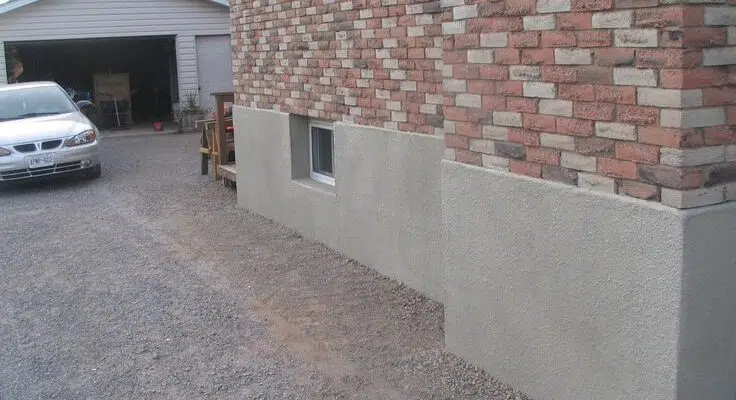
Parging, is a thin layer of mortar applied to the exteriors of concrete or masonry surfaces, such as foundation walls, bricks, or stones. This coating, typically composed of Portland cement, sand, and water, creates a durable and visually appealing finish. Parging is not only about covering and protecting exposed masonry surfaces but also about providing a smooth, uniform appearance. This acts as a barrier against moisture, insect infiltration, and other potential damages.
Historically, the practice of parging dates back to ancient civilizations and has been integral in modern residential architecture. It is a popular choice among homeowners looking to enhance both the appearance and durability of their foundation walls and other masonry structures. Whether you own a historic home with original masonry or a newer construction with concrete foundations, parging offers numerous benefits to protect and beautify your property.
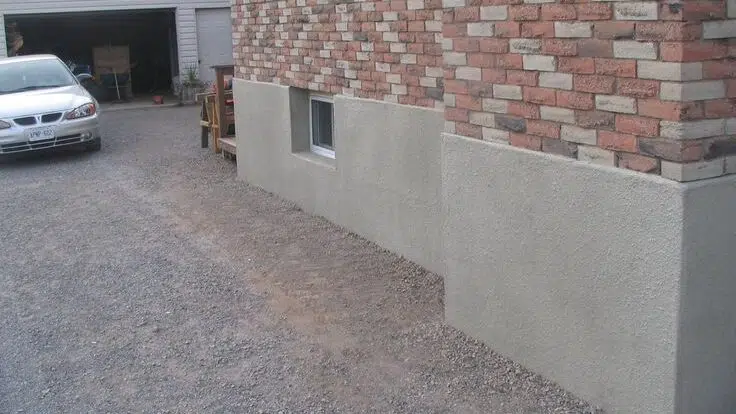
One of the key purposes of parging is to boost the aesthetic appeal of masonry surfaces. When applied properly, parging imparts a smooth, uniform finish that significantly enhances the exterior look of a home. This is particularly beneficial for older properties with exposed foundation walls or those with mismatched or damaged masonry. Parging allows homeowners to achieve a polished and cohesive exterior by covering these imperfections with a consistent layer of mortar.
Parging offers the flexibility to customize the color and texture of masonry surfaces. Moreover, homeowners can add pigments to the parging mix or choose a decorative finish, creating a unique and attractive look that complements their home’s style and landscaping. This flexibility opens up a plethora of creative possibilities, from sleek, modern finishes to more traditional, rustic aesthetics.
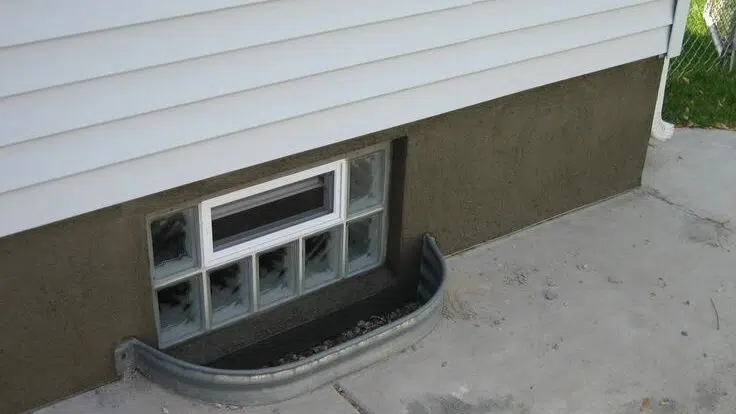
Besides its decorative appeal, parging plays several crucial functional roles. Firstly, it acts as a protective barrier against moisture intrusion. By shielding the masonry from the elements, parging prevents water from penetrating the pores of concrete or brick. This protection is vital for foundation walls, as excess moisture can cause cracking, spalling, and even structural damage.
Parging also enhances the durability and longevity of masonry surfaces. It protects against weathering, erosion, and physical damage by serving as a sacrificial layer that absorbs the impacts of rain, wind, and environmental stressors. Additionally, it inhibits the growth of mold, mildew, and other harmful organisms. By protecting the underlying masonry, parging extends the life of your home’s exterior and minimizes the need for expensive repairs.
Moreover, parging contributes to improved energy efficiency by sealing small cracks and gaps in masonry surfaces. This helps to reduce air infiltration and heat loss, leading to more consistent indoor temperatures and potentially lower energy bills. Combined with proper insulation and other weatherization measures, parging can be a valuable tool in creating a more comfortable and efficient home environment.
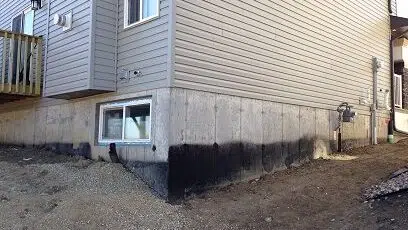
Parging, like many masonry surfaces, is susceptible to cracking and breaking off over time. These issues can arise from several factors, including exposure to the elements, improper application techniques, and underlying structural problems. Water infiltration is a primary culprit, as it causes the parging material to expand and contract with temperature changes. This issue is especially prevalent in regions with cold winters, where the freeze-thaw cycle puts significant stress on the parging, leading to cracks and deterioration. To minimize this type of damage, it’s crucial to ensure that the parging is properly sealed and maintained, and that any signs of cracking or gaps are promptly addressed.
Additionally, improper application techniques can contribute to the failure of parging. If the parging mix is not correctly prepared, or if it’s applied too thickly or unevenly, it may be prone to cracking as it cures. Following manufacturer guidelines and industry best practices for mixing and applying parging is vital. Working with experienced professionals who understand the nuances of achieving a durable, long-lasting finish is equally important.
In some instances, parging may fail completely, detaching from the masonry surface and falling off in large pieces. This failure can stem from poor surface preparation, use of incorrect materials or mix ratios, or exposure to extreme weather conditions. When parging fails, it compromises not only the aesthetic appeal of the masonry but also its structural integrity by leaving the underlying surface vulnerable to moisture, pests, and other hazards.
One common reason for parging failure is inadequate surface preparation. If the masonry surface is not properly cleaned, repaired, and primed before applying parging, the new coating may not adhere correctly, leading to detachment and failure. It is essential to remove all dirt, debris, or loose material from the surface and to repair any cracks or damage before parging. In some cases, applying a bonding agent is necessary to ensure a strong adhesion between the parging and the masonry.
Furthermore, using the incorrect materials or improper mix ratios can lead to parging failure. A mix that is too rich in cement might be prone to cracking as it dries, while a mix that is too sandy or watery might be weaker and more susceptible to erosion and deterioration. Using high-quality, manufacturer-recommended materials and adhering to the proper mixing and application guidelines are critical to avoiding these issues.
Finally, exposure to harsh weather conditions can exacerbate the degradation of parging. In areas with extreme winters or hot, humid summers, parging is subjected to significant stress from temperature fluctuations, moisture, and UV radiation. Over time, this exposure can cause the parging to degrade, crack, and ultimately fail. To minimize weather-related damage, selecting materials suitable for your climate and applying and maintaining the parging according to manufacturer recommendations and industry best practices is essential.
By understanding the common causes of parging failure and taking proactive steps to prevent them, homeowners can help ensure that their parging remains strong, durable, and aesthetically pleasing for years to come. Regular inspections, timely repairs, and proper maintenance are key to identifying and addressing potential problems before they lead to more significant damage or failure.
Parging mix and regular cement have distinct compositions, each tailored for specific masonry applications. While both materials include Portland cement and sand, parging mixes are specially formulated to adhere to vertical surfaces and provide a smooth, uniform finish. This section will discuss the unique properties and benefits of parging in comparison to regular cement.
Acrylic stucco is a modern alternative to traditional parging that offers several advantages. Unlike parging, which is primarily used for protection, acrylic stucco provides both protection and a decorative finish. This section compares the benefits and drawbacks of acrylic stucco to those of parging, helping homeowners make informed decisions about which option best suits their needs.
Besides acrylic stucco, there are other masonry coating options available, such as lime plaster and stone veneers. This section briefly discusses these alternatives, highlighting their unique characteristics and potential uses in residential architecture.
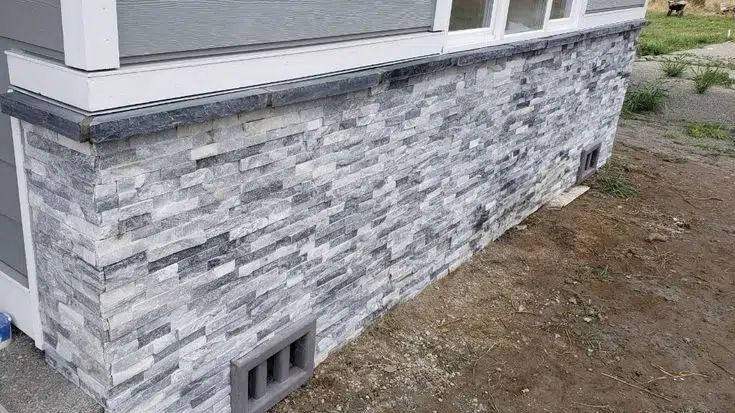
While parging provides a degree of moisture protection, it is not inherently waterproof. This section explains how parging can help prevent moisture intrusion and discusses its limitations as a waterproofing solution.
Sealing parging is crucial for enhancing its moisture resistance and extending its lifespan. This section overviews the benefits of sealing parging and recommends the best types of sealers to use for optimal protection.
The lifespan of parging depends on various factors, including the quality of the application, the materials used, and the exposure to environmental elements. This section discusses the expected longevity of properly applied and maintained parging and factors that can impact its durability.
Recognizing the signs that indicate the need for parging repairs or replacement is crucial for maintaining the structural integrity and appearance of masonry surfaces. This section provides guidance on identifying these signs and recommendations for regular inspections and maintenance to extend the life of parging.
Cracks in parging can be a sign of underlying issues or simply the result of normal wear and tear. This section offers a step-by-step guide to repairing minor cracks and damage in parging, along with tips for identifying and addressing the root causes of the damage.
Proper surface preparation is essential for ensuring that parging adheres correctly and performs its protective functions effectively. This section provides detailed instructions for cleaning and repairing the surface before parging, along with recommendations for the best tools and techniques to use for surface preparation.
Bonding agents play a crucial role in enhancing the adhesion of parging to masonry surfaces. This section explains the function of bonding agents in parging application and provides guidelines for selecting and applying the appropriate bonding agent for your project.
The optimal thickness of a parge coat can vary depending on the application and the specific requirements of the project. This section discusses the recommended thickness for parging coats in different scenarios and offers tips for achieving a consistent and even thickness during application.
Understanding the curing process for parging cement is important for ensuring its durability and effectiveness. This section provides information on the typical curing time for parging cement and recommendations for protecting and caring for fresh parging during the curing process.
Deciding between DIY parging and professional application involves weighing the benefits and challenges of each option. This section compares these two approaches, highlighting the factors to consider when making your decision.
Choosing the right materials is essential for achieving a successful parging application. This section provides an overview of the most popular and reliable parging cement mixes, such as Quikrete, and offers recommendations for selecting the best mix for your specific needs.
Bonding agents are crucial for ensuring that parging adheres properly to masonry surfaces. This section discusses the different types of bonding agents available for parging and provides guidelines for choosing the right bonding agent based on the surface and environmental conditions.
Spray-on parging is an alternative to traditional trowel-applied methods that offers several advantages. This section introduces spray-on parging and compares its benefits and limitations to those of traditional parging methods.
Applying parging to wood surfaces presents unique challenges and considerations. This section explains these challenges and offers recommendations for proper surface preparation and application techniques for parging on wood surfaces.
Cracking is a common issue with parging that can compromise its protective functions and aesthetic appeal. This section discusses the key factors that contribute to cracking in parging and offers tips and best practices for minimizing the risk of cracking during and after application.
Proper adhesion is crucial for the effectiveness and longevity of parging. This section provides an overview of the common reasons why parging may fail to adhere to the surface and offers recommendations for improving bonding and adhesion.
Understanding the underlying causes of parging failure and detachment is essential for preventing future failures. This section explains these causes and outlines steps for identifying and addressing the root issues to ensure the durability and effectiveness of parging.
The cost of parging projects can vary widely based on several factors, including the size of the area to be covered, the materials used, and the complexity of the job. This section discusses the typical costs associated with parging and the factors that can impact the overall cost.
Parging offers several benefits that can enhance the value and functionality of your home. This section highlights the key benefits of parging, including improving energy efficiency, revamping space, and adding defense against damage.
In cold climates, such as the Northeast and Midwest, parging presents unique challenges and considerations. This section discusses these challenges and provides recommendations for materials, application techniques, and maintenance practices that are specific to cold climates.
In hot and humid climates, such as the Southeast and Gulf Coast, parging must be able to withstand high heat and moisture levels. This section offers tips for selecting moisture-resistant materials and preventing mold and mildew growth in these conditions.
In dry climates, such as the Southwest and West, parging faces specific challenges related to curing and durability. This section discusses the importance of proper curing and sealing to prevent cracking and deterioration in arid regions.
In temperate climates, such as the Pacific Northwest and Mid-Atlantic, general considerations and best practices for parging apply. This section provides recommendations for adapting parging techniques and materials to local weather patterns to ensure optimal performance.
This section summarizes the main topics covered in the guide, including the basics of parging, its application, maintenance, and troubleshooting. It emphasizes the importance of proper parging techniques and regular upkeep for homes in all climates.
Investing in quality parging work and prioritizing its maintenance are crucial for the long-term benefits of your home. This section discusses these benefits and encourages homeowners to incorporate parging maintenance and repairs into their overall home care strategy.
The guide concludes with a recap of the key takeaways and action items for homeowners. It invites readers to seek professional guidance and support for their parging and masonry needs and encourages them to embrace the beauty and value of well-maintained masonry in their homes.
Fix My Brick is your go-to masonry expert with over 20 years of experience in all things brick, stone, and mortar. From chimney repair to brick paving and fireplace installation, we have the skills and expertise to handle any brick-related project.
498 Glancaster Rd, Hamilton ON L0R 1W0
55 Village Centre Pl, Mississauga, ON L4Z 1V9
116 Fieldstone Dr, Vaughan, ON L4L 9H2
68 Beverly Hills Dr, North York, ON M3L 1A5
21 Duke St, St. Catharines, ON L2R 5W1
290 King St E, Kitchener, ON N2G 2L2
© 2024 Fix My Brick Inc. All Rights Reserved.